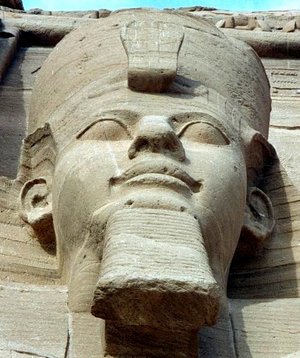Ramses II (reign 1279 BCE to 1213 BCE), also known as Ramesses the Great, was the eldest son of the great Egyptian pharaoh Seti I (reign 1290 BCE to 1279 BCE) by his chief queen Tuya. The third Egyptian pharaoh of the Nineteenth Dynasty, he is often regarded as Egypt’s greatest, most celebrated, as well as most powerful pharaoh in history.
While little is known about his childhood, it is commonly believed that even as a boy, Ramses took extraordinary interest in royal affairs, assuming an ever-increasing role in day-to-day official matters as he matured.
At the young age of fourteen, Ramses was appointed Prince Regent by his father, and shortly afterward, began displaying his prowess in the battlefield. In what is his first recorded military campaign, he accompanied Seti in a five-year crusade against the Libyans, then fought side-by-side with him in Syria.
During the second half of Seti’s reign, Ramses began taking part in his father’s numerous building projects, completing Seti’s temple at Abydos, and then proceeding to build one for himself nearby. Later, he designed the decorative embellishments in the south half of the Hypostyle Hall at Karnak, as well as for his father’s funerary temple on the river at Qurna.
By the end of his father’s sixteen-year reign, Ramses had not only established himself as one of the greatest builders in Egyptian history, but as a skilled warrior of superhuman proportions–his extraordinary prowess documented by numerous neighboring cultures such as the Hittites.
Taking the throne in his early 20s, he decreed his royal titles as: Horus, Strong Bull, Beloved of Ma’at; The Two Goddesses, Protector of Egypt, Subduer of Foreign Lands; Horus of Gold, Rich in Years, Great of Victories; King of Upper and Lower Egypt, The Truth of Re is Strong; and Son of Re, Ramses II, Beloved of Amun. Clearly, Ramses intended to leave his mark on the world in no small way–and set unprecedented goals for himself.
In the fifth year of his reign, Ramses led his army to the city of Kadesh on the Orontes River (Anatolia, modern Turkey, mentioned numerous times in the Hebrew Bible) where he hoped to defeat the Hittites and force them to relinquish power of northern Syria.
At the time, Egypt as an empire was in the throes of constant attack from outside forces, and was spending much of its resources defending the homeland. Ramses decided to take the battle to the Hittites rather than allow them to formally invade. The events of this battle are well preserved in both Hittite and Egyptian documents, detailed in the Egyptian account The Bulletin and the narrative called The Poem.
According to these accounts, as well as beautiful depictions that can still be seen on the walls of the temple at Abu Simbel and every other major monument of the era, Ramses left Egypt with four divisions, leading the army himself. Arriving at Kadesh one month later, he left three-fourths of his army a few miles outside the city and charged directly into the metropolis with a single division.
En route, Ramses was met by two Hittite spies who reported that Muwatallis, the Hittite king, had retreated far to the north upon hearing of Ramses’ approach. Feeling at ease, Ramses set up camp for the night on the city outskirts. That night after being tortured, however, the spies admitted that Muwatallis and his army was actually just to the east side of Kadesh.
Before Ramses could muster his forces, the Hittites attacked, mounting a full-scale chariot assault.
Ramses, according to all accounts, leapt on his chariot and held off the encroaching charioteers virtually single-handedly, until reinforcements could arrive. Surrounding the Hittite forces, the Egyptians, led by Ramses, then were able to push the Hittites back across the river. Ramses prudently called a halt to the fighting until the remainder of his two divisions could arrive.
The next morning, Ramses led one of the most well-known battles in military history, during which the two armies eventually fought to a stalemate. Though the Hittites outnumbered the Egyptians two-to-one, Ramses had wreaked such havoc on their chariots the day before that the armies were now evenly matched. Although the Battle of Kadesh was over, the war had just begun.
Over the course of the next five years, Ramses lead several more assaults on the Hittites, but was ultimately unable to dislodge them from northern Syria due to their superior numbers and having to divide his forces between field soldiers and home defenders.
Finally in the twenty-first year of his rule, Ramses and the Hittite king Hattusilis III signed a non-aggression, mutual defense treaty (one of the first in history), copies of which were found in both the Hittite capital of Hattusas as well as in Egypt. So greatly did relations improve from that time on that Ramses even married one of the Hittite king’s daughters.
In addition to establishing himself as a major military force of the Mediterranean and Near East, Ramses‘ renown as a builder is evident by the numerous monuments he produced, and recorded by several neighboring cultures, particularly the Nubians to the south.
Among them, the Great Hypostyle (a ceremonial hall dedicated to Karnak), the Ramesseum (a funerary temple dedicated to himself and fellow god Amon), the great temple at Abydos (dedicated to the god Osiris), several structures at Memphis (which have since been pillaged), the Luxor temple, and of course, the Abu Simbel temples in Nubia.
Of special significance is the Luxor temple complex, completed in the third year of Ramses‘ reign, as it drew international publicity in 1960 when it had to be disassembled and then reassembled on higher ground so as not to be submersed by the waters of Lake Nasser. Known as Ramses the Great’s most awe-inspiring tribute to himself, the temple displays four colossal statues of himself, each sixty-five feet high on the façade of the main temple.
Ramses II died in the second month of the sixty-seventh year of his reign, at about the age of ninety-two.
While his son and successor, Merneptah, was being crowned, Ramses was being prepared for burial; the traditional mummification process requiring seventy days by Egyptian religious law. Packed with stuffing and wrapped in linen, Ramses was enclosed in a series of nested coffins made of gold, and transported to Thebes for burial.
Ramses’ tomb in the Valley of the Kings lies near the modern entrance to the east valley.
His mummy can be found today in Cairo’s Egyptian Museum.
References:
http://www.absoluteastronomy.com/topics/Hittites
http://www.awakening-healing.com/Ramses_II
http://www.reshafim.org.il/ad/egypt/ramseskadeshcampaign
Related Articles:
The Egyptian Book of the Dead
The Rosetta Stone
Akhenaton
Visit JAMES R. COFFEY WRITING SERVICES & RESOURCE CENTER for more information


